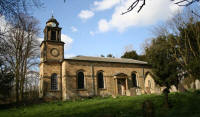 Ossington Church of the Holy Rood |
|||
|
|||
 |
|||
|
The village is centred around the site of Ossington Hall, the ancestral home of the Denison family. The house was demolished in 1964 and all that remains are a few out-buildings and the private chapel which now serves the parish as the Church of the Holy Rood. This is a Grade I listed church, originally 12th Century and rebuilt in 1782-83, by architect John Carr, with minor nineteenth century alterations and additions. It includes earlier monuments and stained glass and there is a barrel organ built by Thomas Robson in 1840. The estate can be traced back to Saxon times when it was known as "Oschinton" and then later in 1144 as "Oscinton". The lord at that time, Roger de Burun, gave the estate to the Cluniac order of monks when he entered the order as an act of penitence. He neglected to recall that he had earlier made the property over to the Hospitallers of St. John of Jerusalem. A legal dispute followed between the two religious orders, which the Hospitallers won and they retained ownership until the Dissolution of the monasteries around 1539. The estate was eventually bought by the Cartwright family who have monuments in the church. The house was damaged during the Civil War and in 1753 passed to Mr. William Denison, a successful merchant of Leeds. It remained in the Denison family up to the modern times and was extended and remodelled. Following World War II, however, it had fallen into disrepair and was eventually demolished. |
|||
| The Barrel Organ | |||
|
Barrel Organ dated by Langwill (1970) as c. 1840, placed in a small recess at the west end of the church and operated from the rear on a small platform in the tower wall. Foot blown. Three stops : compass 27 notes : 3 barrels stored in cases. The barrel organ was first restored at the instance of the Bishop of Sherwood, the Rt. Rev'd K. G. Mander and Dr W. L. Sumner, and was broadcast on radio on 13 May 1968. The National Pipe Organ Register takes the slightly earlier date of c. 1830, and confirms the earlier restoration as being the work of John Budgen, who "brought it back into use". There has since been a further restoration of the organ, by Aistrup & Hind in 2005, this including recovering the bellows with leather, cleaning the casework, cleaning and repairing the pipework, and checking and repairing as necessary all mechanical parts. A grant of £500 was made by the Georgian Society. |
|||
|
|||
|
|||
|
Picture from Wikipedia by Richard Croft, under CC Licence. |
|||
|
|
|||
|
|
|||